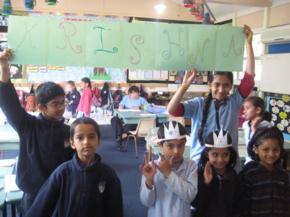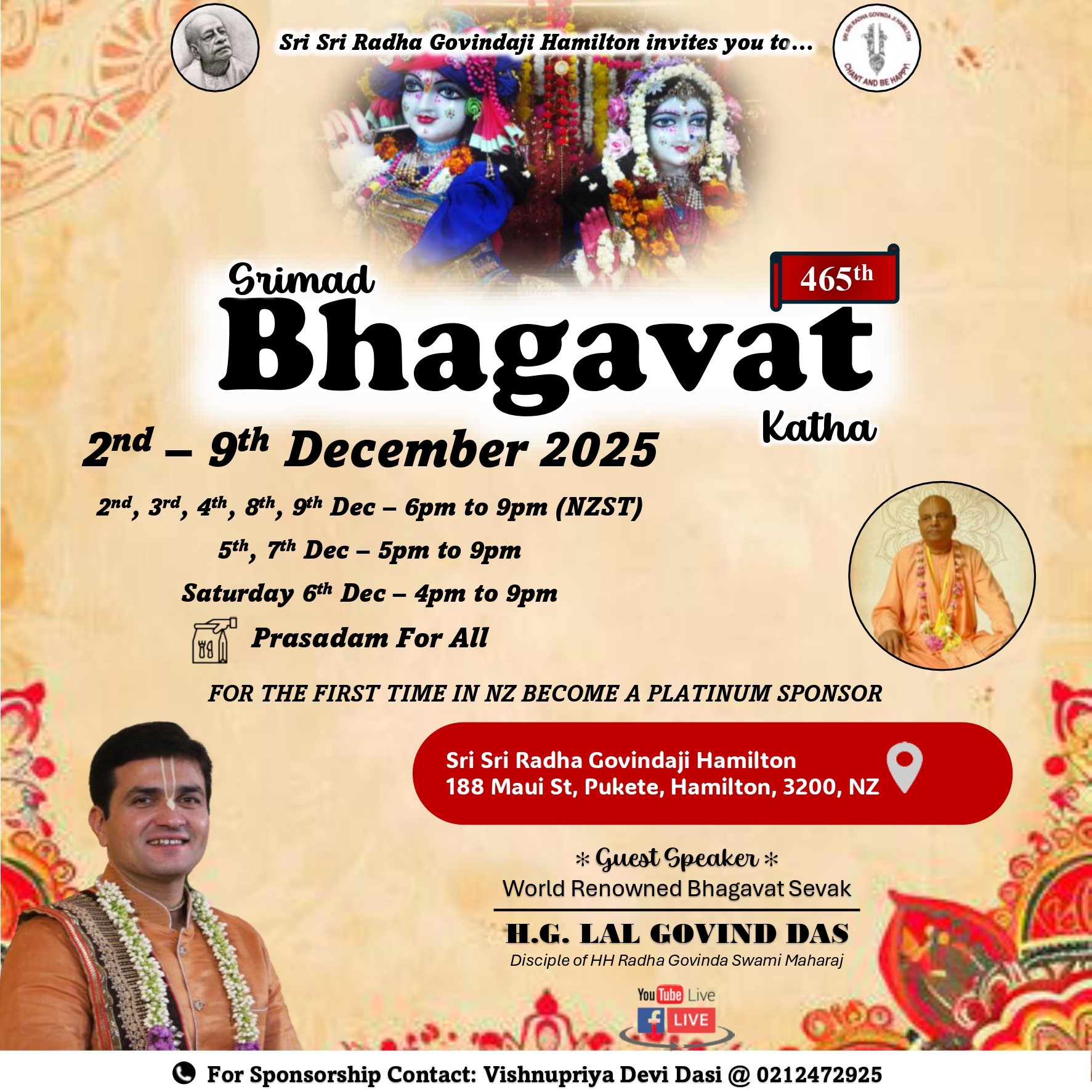A State School with a Difference

Hare Krishna primary school in Kumeu, just outside Auckland, is a state integrated school run by the International Society for Krishna Consciousness (ISKCON). Srila Prabhupada, the Founder Acharya of Iskcon, established over 108 temples throughout the world as well as numerous farming communities and schools.
His schooling system is based on the principles of the ancient Gurukula system, which aims to empower children to maximise their individual potential and to develop positive character traits such as truthfulness, simplicity, obedience cleanliness, compassion and self-control.
The Hare Krishna school in Kumeu is also based on the Gurukula system though it is not residential.
The school has two buses that go and pick up students from different parts of Auckland. Besides it has a van that goes up to Onehunga to pick up students.
There is a community of Hare Krishna devotees around the school and the focal point is the Radha Giridhari Temple, which is just next to the school. Everyday the students go for a run around the temple.
The school has Years 1 to 8 and full New Zealand curriculum is taught under the direction of the Ministry of Education. However, it is unique in several ways. While many schools may offer a second language to the pupils, Hare Krishna school must be the only one in NZ that offers Sanskrit. Similarly, while most other schools teach how to play musical instruments, this must be the only school that teaches ‘mridangam’ and harmonium.
The principal, Prana dasa, who is from Australia had joined Iskcon in 1985. When I first visited the school I was pleasantly surprised to see him dressed traditionally in a ‘dhoti’. The staff are international (they come from the UK, India, Fiji, Malaysia not to mention New Zealand). Most of them are members of the Hare Krishna movement, but even the few who are not are worshippers of Krishna.
The school library, while it has books that one would find in any primary school library (easy readers, mystery and adventure etc.) also has books that are not found in any other school library in New Zealand such as ‘Amar Chitra Katha’ (Indian classics in comic form).
The library is just opposite the temple and it is not just a school library. It is called the Bhakthi Vedanta Resource Centre and Community Library and it also has a complete collection of books by Srila Prabhupada and other books related to ISKCON. Any one is welcome to become a member of the library by paying an annual subscription of $10.00 and borrow books.
I am told that often on Sundays devotees who come to the temple for worship also visit the library which is just across from the temple and borrow books. When visitors to Auckland go sight seeing, they sometimes come to the Hare Krishna centre. While I was there one day a bus load of new immigrant women came with their English teacher to see the temple and they also visited the library.
At midday the pupils are given hot lunch which is cooked in the school kitchen. Hare Krishna devotees are strict vegetarians and they do not even use onion or garlic in their cooking. The children sit on the floor cross-legged on the mats and they are served by the teachers. The women teachers are all addressed as ‘mataji’ (mother). I have seen the principal sometimes joining the children sitting on the mat, and having lunch with them.
In and around the school men and women are seen moving about in traditional Indian costumes – men in dhoti and women in sari – and many of them are not Indians. In school, following Hindu tradition, shoes are not worn inside so they are left outside the classrooms. Some of the boys also have the traditional long hair (grown only in part and tied).
The school has a roll of just over a hundred children. So it is a small school and it has its advantages.
The staff student ratio is better than in most schools and the children are able to get individual attention. I was amazed at the reading ability of 5 and 6 year olds. I am told that they do equally well in writing. I have also seen their artwork which is remarkable.
Though the majority of the children are Indians, there are also European and Maori, Islanders, Chinese, Filipino, Russian, American and Fijian. Apart from English, arts, social sciences, science, mathematics etc. the school also has ‘sastra’ to develop a spiritual perspective in the children. The children grow up learning to respect everyone. So there are few discipline problems as the children are on the whole well behaved.
The school is partially funded by the Ministry of Education, which pays the salaries of the teachers. The Hare Krishna school was mentioned, along with church schools, as an example of a charter school, which are in the news. A recent US study of charter schools concluded that 17 per cent were superior while 37 per cent were worse than the state schools.
Hare Krishna school, if it is to be classified as a charter school, certainly falls in the superior category. There are two main reasons for this. One is the dedication and hard work of the staff. The staff student ratio and the attention the children get as a result also contribute to better quality.
Here the staff consider their work as part of their worship of Krishna. So the all round development of the children – physically, emotionally, psychologically and spiritually – is emphasised and their creative talents are nurtured. It is the philosophy of the administration (which focuses on Vedic culture) and the sincere efforts of the staff to implement it that make this school a truly remarkable school.
Hare Krishna primary school in Kumeu, just outside Auckland, is a state integrated school run by the International Society for Krishna Consciousness (ISKCON). Srila Prabhupada, the Founder Acharya of Iskcon, established over 108 temples throughout the world as well as numerous farming communities...
Hare Krishna primary school in Kumeu, just outside Auckland, is a state integrated school run by the International Society for Krishna Consciousness (ISKCON). Srila Prabhupada, the Founder Acharya of Iskcon, established over 108 temples throughout the world as well as numerous farming communities and schools.
His schooling system is based on the principles of the ancient Gurukula system, which aims to empower children to maximise their individual potential and to develop positive character traits such as truthfulness, simplicity, obedience cleanliness, compassion and self-control.
The Hare Krishna school in Kumeu is also based on the Gurukula system though it is not residential.
The school has two buses that go and pick up students from different parts of Auckland. Besides it has a van that goes up to Onehunga to pick up students.
There is a community of Hare Krishna devotees around the school and the focal point is the Radha Giridhari Temple, which is just next to the school. Everyday the students go for a run around the temple.
The school has Years 1 to 8 and full New Zealand curriculum is taught under the direction of the Ministry of Education. However, it is unique in several ways. While many schools may offer a second language to the pupils, Hare Krishna school must be the only one in NZ that offers Sanskrit. Similarly, while most other schools teach how to play musical instruments, this must be the only school that teaches ‘mridangam’ and harmonium.
The principal, Prana dasa, who is from Australia had joined Iskcon in 1985. When I first visited the school I was pleasantly surprised to see him dressed traditionally in a ‘dhoti’. The staff are international (they come from the UK, India, Fiji, Malaysia not to mention New Zealand). Most of them are members of the Hare Krishna movement, but even the few who are not are worshippers of Krishna.
The school library, while it has books that one would find in any primary school library (easy readers, mystery and adventure etc.) also has books that are not found in any other school library in New Zealand such as ‘Amar Chitra Katha’ (Indian classics in comic form).
The library is just opposite the temple and it is not just a school library. It is called the Bhakthi Vedanta Resource Centre and Community Library and it also has a complete collection of books by Srila Prabhupada and other books related to ISKCON. Any one is welcome to become a member of the library by paying an annual subscription of $10.00 and borrow books.
I am told that often on Sundays devotees who come to the temple for worship also visit the library which is just across from the temple and borrow books. When visitors to Auckland go sight seeing, they sometimes come to the Hare Krishna centre. While I was there one day a bus load of new immigrant women came with their English teacher to see the temple and they also visited the library.
At midday the pupils are given hot lunch which is cooked in the school kitchen. Hare Krishna devotees are strict vegetarians and they do not even use onion or garlic in their cooking. The children sit on the floor cross-legged on the mats and they are served by the teachers. The women teachers are all addressed as ‘mataji’ (mother). I have seen the principal sometimes joining the children sitting on the mat, and having lunch with them.
In and around the school men and women are seen moving about in traditional Indian costumes – men in dhoti and women in sari – and many of them are not Indians. In school, following Hindu tradition, shoes are not worn inside so they are left outside the classrooms. Some of the boys also have the traditional long hair (grown only in part and tied).
The school has a roll of just over a hundred children. So it is a small school and it has its advantages.
The staff student ratio is better than in most schools and the children are able to get individual attention. I was amazed at the reading ability of 5 and 6 year olds. I am told that they do equally well in writing. I have also seen their artwork which is remarkable.
Though the majority of the children are Indians, there are also European and Maori, Islanders, Chinese, Filipino, Russian, American and Fijian. Apart from English, arts, social sciences, science, mathematics etc. the school also has ‘sastra’ to develop a spiritual perspective in the children. The children grow up learning to respect everyone. So there are few discipline problems as the children are on the whole well behaved.
The school is partially funded by the Ministry of Education, which pays the salaries of the teachers. The Hare Krishna school was mentioned, along with church schools, as an example of a charter school, which are in the news. A recent US study of charter schools concluded that 17 per cent were superior while 37 per cent were worse than the state schools.
Hare Krishna school, if it is to be classified as a charter school, certainly falls in the superior category. There are two main reasons for this. One is the dedication and hard work of the staff. The staff student ratio and the attention the children get as a result also contribute to better quality.
Here the staff consider their work as part of their worship of Krishna. So the all round development of the children – physically, emotionally, psychologically and spiritually – is emphasised and their creative talents are nurtured. It is the philosophy of the administration (which focuses on Vedic culture) and the sincere efforts of the staff to implement it that make this school a truly remarkable school.









Leave a Comment